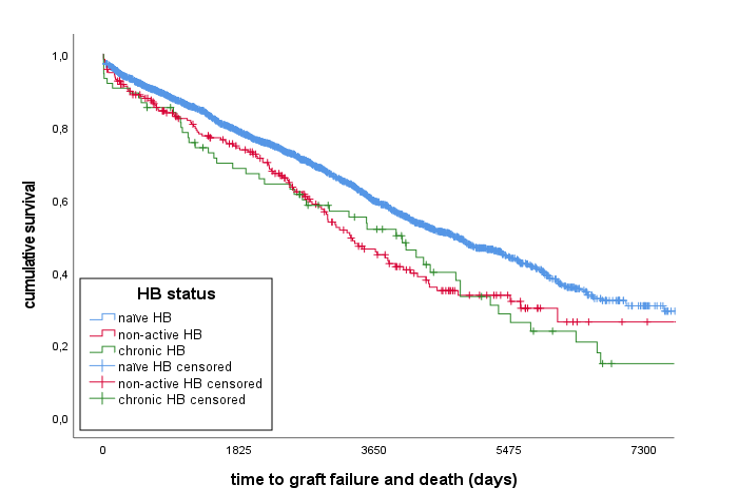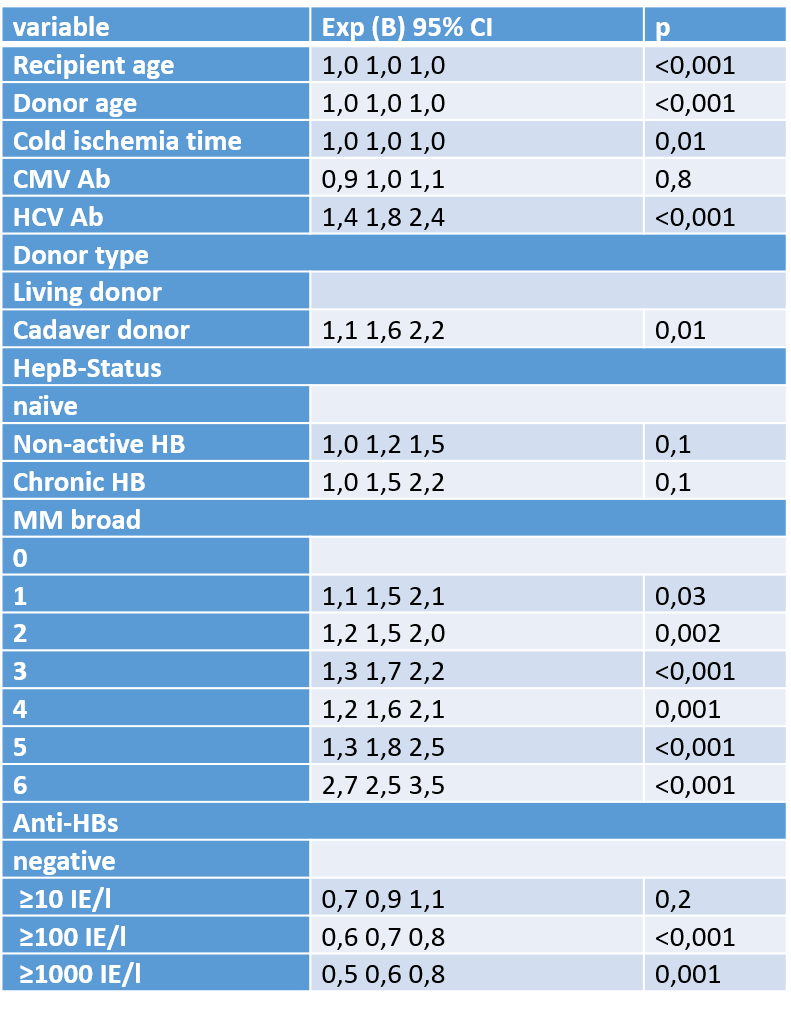Impact of Non-active Hepatitis B on Patient Survival After Renal Transplantation
A. Paschereit1, K. Budde2, M. Duerr2, M. G. Naik2
1Medical Department, Division of Nephrology and Internal Intensive Care Medicine, Charité University Medicine Berlin, Berlin, Germany, 2Medical Department, Division of Nephrology and Internal Intensive Care Medicine, Charité, Berlin, Germany
Meeting: 2021 American Transplant Congress
Abstract number: 792
Keywords: Hepatitis B, Kidney transplantation, Risk factors, Survival
Topic: Clinical Science » Infectious Disease » Kidney Infectious Non-Polyoma & Non-Viral Hepatitis
Session Information
Session Name: Kidney Infectious Non-Polyoma & Non-Viral Hepatitis
Session Type: Poster Abstract
Session Date & Time: None. Available on demand.
Location: Virtual
*Purpose: Dialysis patients (pts) have an increased risk for hepatitis B (HB) infection and impaired response to HB vaccine compared to the general population. As shown in other studies, pts and graft survival in pts with chronic HB is worse. This study assesses the outcome of HBc-positive patients after kidney transplantation (KTx).
*Methods: In our retrospective analysis we included all pts >18 years old, who underwent KTx from 01.01.1990 to 31.08.2019 in our center. Pts were grouped by their serostatus prior to KTx into “A: naïve” (HB negative), “B: HBc-positive” (non-active HB) and “C: HBsAg-positive” (chronic HB). Primary endpoints included pts and graft survival analyzed with Kaplan-Meier (KM) and log-rank test. Regression analysis (RA) was applied to determine independent risk factors for the occurrence of primary endpoints.
*Results: Out of 2487 KTx pts we identified n=2198 HB naïve, n=218 non-active HB and n=75 chronic HB pts. Overall 29.1% (A:27.7%, B:37.6%, C:45.3%) pts died and 20.3% (A:19.1%, B:27.5%, C:37.3%) pts suffered from graft failure. 5-year pts survival was A: 87.0%, B: 82.8%, C: 82.2%. 10-year pts survival was A: 71.7%, B: 61.1%, C: 64.5% and 20-year pts survival was A: 43.1%, B: 26.1%, C: 40.9% (p=0.01). Pts and graft survival rate (fig. 1) was: 5 year A: 78,7%, B: 74,2%, C: 68,6%, 10 year A: 59.8%, B: 46.4%, C: 51.8%, 20 year A: 30.8%, B: 26.4%, C: 14.9% (p=<0.001). RA (fig. 2) showed that anti-HBs positivity (≥100 IE/l) was a protective factor for graft failure and death (p<0.001).
*Conclusions: HB leads to earlier graft loss and inferior pts survival. Beside the known negative effect of chronic HB, also in pts with non-active HB infection overall survival was significant worse to HB naïve pts. Thus, non-active HB is an important risk factor for transplant outcome. Next, influence of antiviral and immunosuppressive regimens and incidence of HB-reactivation are to be analyzed.
To cite this abstract in AMA style:
Paschereit A, Budde K, Duerr M, Naik MG. Impact of Non-active Hepatitis B on Patient Survival After Renal Transplantation [abstract]. Am J Transplant. 2021; 21 (suppl 3). https://atcmeetingabstracts.com/abstract/impact-of-non-active-hepatitis-b-on-patient-survival-after-renal-transplantation/. Accessed December 14, 2025.« Back to 2021 American Transplant Congress


